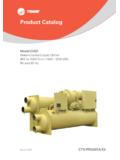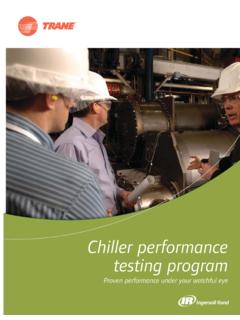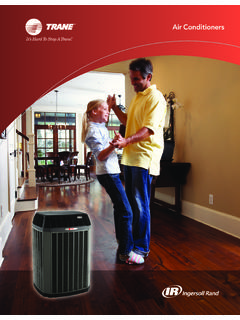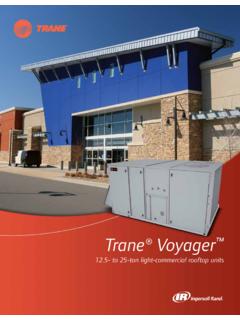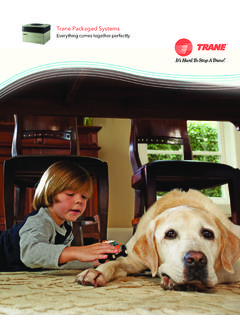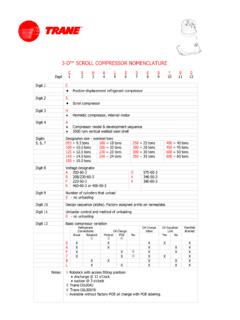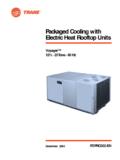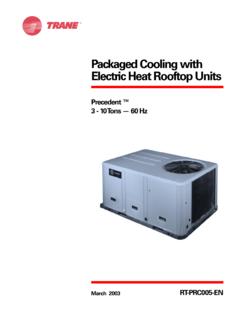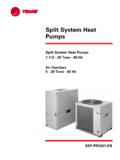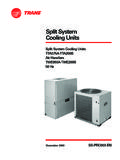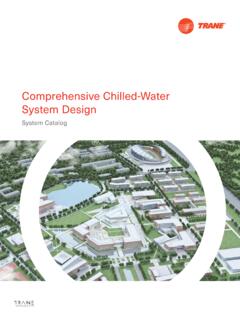Transcription of Understanding Chilled Beam Systems - Trane
1 Providing insights for today s hvac system designer 2011 Trane , a business of Ingersoll-Rand. All rights reservedl1engineersvolume 38 4newsletterAlthough Chilled beam Systems have been used in Europe and Australia for many years, they are a new concept to many in the Those interested in learning more about these Systems , as with any new concept, are faced with the task of discerning its true strengths and weaknesses. The goal of this EN is to investigate the common claims about Chilled beam Chilled Beam SystemsOverview of Chilled Beam SystemsPassive Chilled beams (PCB). A PCB consists of a fin-and-tube heat exchanger, contained in a housing (or casing), that is suspended from the ceiling (Figure 1).
2 Chilled water passes through the tubes. Warm air from the space rises toward the ceiling, and the air surrounding the Chilled beam is cooled, causing it to descend back toward the floor, creating convective air motion to cool the space. This allows a passive Chilled beam to provide space cooling without the use of a air system. To comply with most building codes in the , outdoor air must be supplied to each space for ventilation. And since a Chilled beam (whether passive or active) typically does not contain a condensate drainage system, the primary air system must also maintain the dew point of the indoor air below the surface temperature of the Chilled beam to avoid moisture from condensing on the coil and dripping into the , the purpose of the primary air system for active Chilled beams is to.
3 1) Deliver at least the required amount of outdoor air to each space for ventilation, and2) Deliver air which is dry enough to offset the space latent load and maintain the indoor dew point low enough to avoid condensation on the Chilled beams, and3) Deliver enough air to induce sufficient room airflow to offset the space sensible cooling Chilled beams (ACB). An ACB also consists of a fin-and-tube heat exchanger contained in a housing that is suspended from, or recessed in, the ceiling (Figure 1). The primary difference is that an active Chilled beam contains an integral air supply. This primary air passes through nozzles, which induce air from the space up through the cooling coil.
4 This induction process allows an active Chilled beam to provide much more cooling capacity than a passive Chilled beam. For this reason, active Chilled beams are more commonly used, and are the focus of this 2 includes examples of active Chilled beams. They have pipe connections and a primary air connection. Note that either two- or four-pipe designs are available. With the two-pipe design, all zones receive either cold water or hot water . The benefit of the four-pipe design is that some zones can receive cold water for space cooling, while other zones simultaneously receive hot water for space 1. Passive versus active Chilled beamsceilingperforated metal casingcoilpassive Chilled beamcoilprimary airinduced airinduced air +primary airactive Chilled beamFigure 2.
5 Examples of active Chilled beams2lTrane Engineers Newsletter volume 38 4providing insights for today s HVAC system designerCloser Investigation of AdvantagesThe goal of this section is to assess the common claims about active Chilled beam Systems . Claimed advantage 1: An ACB system typically allows for smaller ductwork and smaller air-handling units than a variable-air-volume (VAV) system. Because active Chilled beams provide some of the space cooling using induced airflow, primary airflow delivered by the central air-handling unit (AHU) is typically less than the design primary airflow delivered by the AHU in a conventional VAV system. Therefore, ACB Systems typically allow for smaller ductwork and AHUs than a conventional VAV on how the ductwork is routed, smaller ducts can sometimes allow for shorter floor-to-floor heights.
6 And because the primary AHUs will likely be smaller, a building with Chilled beams may require less floor space for mechanical primary airflow delivered to an active Chilled beam must be the largest of the following:1) The minimum outdoor airflow required by ASHRAE Standard or the local building code.[1]2) The dry airflow needed to offset the indoor latent load and maintain the space dew point low enough to avoid condensation on the Chilled beams. Of course, the quantity of air needed for this purpose depends on how dry that air is. If the primary air is delivered drier (at a lower dew point), then less airflow is ) The primary airflow (PA) needed to induce sufficient room air (RA) to offset the design space sensible cooling load (Figure 3).
7 If more primary air is delivered through the nozzles, more room air will be induced through the Chilled beam coils, resulting in greater cooling 1 demonstrates the impact of these three functions for an example office space. Using the default occupant density from ASHRAE , the minimum outdoor airflow required for an office space is cfm per square foot of floor on typical occupant latent loads in an office space, if primary airflow is only cfm/ft2, it must be dehumidified to 47 F dew point to offset the space latent load and maintain the indoor dew point at 55 F (75 F dry bulb and 50 percent RH). However, if primary airflow is increased, the primary air would not need to be dehumidified as much (Table 1).
8 Finally, based on typical sensible cooling loads in an office space, catalog performance data from several manufacturers of active Chilled beams indicates that between and cfm/ft2 of primary air is required to provide the required sensible cooling this same example office space, the design airflow delivered by a conventional VAV system would be cfm/ft2. At design cooling conditions, primary airflow required for the ACBs serving this space is 60 percent less than for the conventional VAV system. However, this does not translate to a 60 percent reduction in fan energy use, as will be discussed later in this EN under the claimed advantage 3 you can see from this example (Table 1), the primary airflow required for space sensible cooling in the ACB system is four times larger than the minimum outdoor airflow requirement PARASASAF igure 3.
9 Primary airflow (PA) in an active Chilled 1. Zone-level primary airflow for an example office spaceMinimum outdoor airflow required (per ASHRAE ) cfm/ft2(for LEED EQ credit, x = cfm/ft2)Active Chilled -beam systemPrimary airflow required to offset space latent cfm/ft2 (DPTPA=47 F or WPA=47 gr/lb) cfm/ft2 (DPTPA=49 F or WPA=51 gr/lb) cfm/ft2 (DPTPA=53 F or WPA=60 gr/lb)Primary airflow needed to induce sufficient room airflow to provide sensible cooling3mfr A: cfm/ft2 (DBTPA = 55 F)mfr B: cfm/ft2 (DBTPA = 55 F)mfr C: cfm/ft2 (DBTPA = 55 F)Conventional VAV systemPrimary airflow needed to provide sensible cfm/ft2 (DBTPA = 55 F)1 For an office space, Table 6-1 of ASHRAE Standard , Ventilation for Acceptable Indoor Air Quality, requires 5 cfm/p (Rp) plus cfm/ft2 (Ra), and suggests a default occupant density of 5 people/1000 ft2: Vbz = (5 cfm/person x 5 people/1000 ft2) + cfm/ft2 = For moderately active office work, the 2009 ASHRAE Handbook-Fundamentals (Table 1, Chapter 18) suggests a latent load of 200 Btu/h/person.
10 Using the same default occupant density (5 people/1000 ft2): Qlatent = (200 Btu/h/person x 5 people/1000 ft2) = Btu/h/ft2 = x VPA x (Wspace - WPA). Assuming a space dew point target of 55 F (64 gr/lb): VPA = Btu/h/ft2 / ( x (64 - 47 gr/lb) = cfm/ft2, VPA = Btu/h/ft2 / ( x (64 - 51 gr/lb) = cfm/ft2, or VPA = Btu/h/ft2 / ( x (64 - 60 gr/lb) = For an office space, the space sensible cooling load typically ranges from 17 to 24 Btu/h/ft2 (which equates to about to cfm/ft2 if a conventional VAV system is used). Assuming a space sensible cooling load of Btu/h/ft2, a zone cooling setpoint of 75 F, and a primary-air dry-bulb temperature of 55 F, product literature from manufacturer A indicates that four (4) 6-ft long, 4-pipe, 2-way discharge active Chilled beams require cfm/ft2 to offset the design space sensible cooling load.)))
